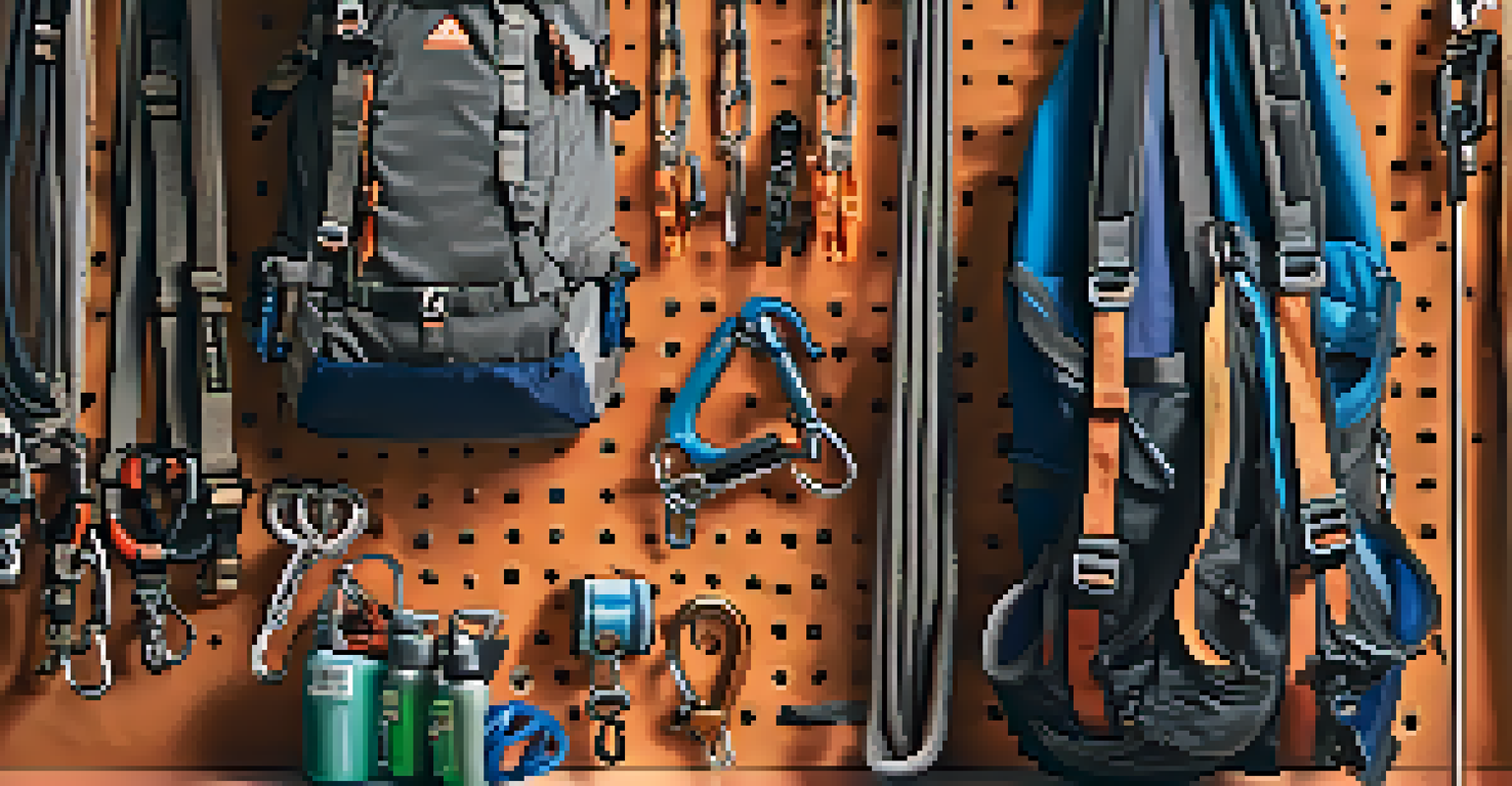Climbing Etiquette: Important Rules Every Climber Should Follow

Respect the Climbing Area and Its Environment
When you're out climbing, it's crucial to respect the natural environment. This means sticking to designated trails and avoiding trampling on vegetation, which can take years to recover. Think of it as being a guest in someone's home; you wouldn't want to leave a mess behind, would you?
The mountains are calling, and I must go.
Additionally, be mindful of wildlife in the area. Animals are often sensitive to disturbances, and your presence can affect their natural behavior. By keeping a respectful distance and minimizing noise, you help maintain the balance of the ecosystem, allowing everyone to enjoy the beauty of nature.
Finally, practice Leave No Trace principles. Bring back any trash you create, whether it's a water bottle or a snack wrapper. This simple act not only enhances the climbing experience for yourself and others but also preserves the beauty of the climbing area for future generations.
Communicate Clearly with Fellow Climbers
Effective communication is key in climbing. Whether you're belaying or climbing, clear verbal cues can prevent accidents and ensure everyone is on the same page. Using simple commands like 'climbing,' 'slack,' or 'take' helps eliminate confusion and keeps the flow of your climbing session smooth.

Moreover, if you're climbing in a crowded area, it's essential to let others know your intentions. For instance, if you plan to take a break or need to pass another climber, a quick heads-up can go a long way in avoiding potential collisions. Think of it as a dance; everyone has a role to play, and coordination is vital.
Respect Nature in Climbing Areas
Always stick to trails, minimize noise, and follow Leave No Trace principles to protect the environment while climbing.
Lastly, be aware of your surroundings and the people around you. If you notice someone struggling, offer assistance or encouragement. Climbing is often about camaraderie, and fostering a supportive environment benefits everyone involved.
Yielding to Other Climbers: The Right of Way
In the climbing community, yielding to others is a fundamental courtesy. If you’re on a route and see someone below you who wants to climb it, it's considerate to let them go first, especially if they were there before you. This helps keep the flow of climbing uninterrupted and makes for a more enjoyable experience for all.
Climbing is as much about the journey as it is about the destination.
Likewise, if you're climbing a popular route, be aware of those waiting to climb. If you plan to take a long break, consider stepping aside to allow others to enjoy the climb. Think of it as sharing a popular dish at a potluck; everyone deserves a taste!
Ultimately, understanding the right of way in climbing fosters a positive atmosphere. When everyone respects this unwritten rule, it helps build goodwill and creates lasting friendships within the climbing community.
Know and Follow Climbing Area Rules
Every climbing area has its own set of rules, and knowing them is essential for a safe and respectful experience. These rules can vary from restrictions on certain routes to guidelines about specific climbing techniques. Before you start your climb, take a moment to familiarize yourself with the area’s regulations.
In some regions, there may be seasonal closures to protect nesting birds or fragile ecosystems. Respecting these rules not only shows your commitment to the environment but also helps preserve the areas we love for future climbers. Think of it as being part of a team; when one person follows the rules, it benefits everyone.
Communicate with Fellow Climbers
Use clear verbal cues and keep others informed of your intentions to ensure a safe and enjoyable climbing experience.
Additionally, if you're unsure about any rules, don’t hesitate to ask local climbers or guides. They can provide valuable insights and help you navigate the area responsibly. Remember, being informed is just as important as being enthusiastic about climbing.
Be Mindful of Your Gear and Its Placement
Gear management is a crucial aspect of climbing etiquette. Always store your equipment in designated areas to prevent creating hazards for others. Imagine a busy kitchen; if everyone leaves their utensils lying around, it could lead to accidents. The same principle applies to climbing areas!
When setting up your gear, be conscious of your surroundings. Avoid blocking trails and routes with your bags or equipment, as this can create unsafe conditions for climbers passing by. Think of it like taking turns on a seesaw; everyone should have space to enjoy their climb without obstruction.
Lastly, ensure that your gear is in good condition and suited for the environment. Regularly check your harness, ropes, and carabiners for wear and tear. By maintaining your equipment, you not only ensure your safety but also demonstrate respect for the climbing community.
Practice Good Hygiene in Shared Spaces
Climbing often brings us together in communal spaces like campgrounds or climbing gyms, making hygiene especially important. Before and after your climb, wash your hands and keep your gear clean. Just as you wouldn’t want to share a cup with someone who hasn’t washed it, maintaining cleanliness helps keep everyone healthy.
Be mindful of your personal space and the comfort of others around you. If you’re in close quarters, consider minimizing strong scents from food or body odor. It’s like sharing an elevator; everyone appreciates a pleasant environment!
Foster Inclusivity and Safety
Encourage new climbers, celebrate achievements, and know your limits to create a welcoming and secure climbing community.
Lastly, if you’re using shared facilities like restrooms or showers, make sure to leave them tidy for the next person. A little consideration goes a long way in fostering a positive climbing community and enhancing everyone's experience.
Encourage New Climbers and Foster Inclusivity
The climbing community thrives on inclusivity, and welcoming new climbers is essential. If you encounter someone who is just starting out, offer them encouragement and guidance. Think of it as passing the torch; sharing your knowledge can help ignite their passion for climbing.
Creating a supportive environment also means celebrating everyone's achievements, no matter how big or small. When climbers cheer each other on, it builds camaraderie and strengthens the community. After all, every climber was a beginner once!

Additionally, consider participating in local climbing events or mentorship programs. These initiatives not only help newcomers but also enrich your own climbing journey. By fostering a culture of inclusivity, we ensure that climbing remains a sport for everyone.
Stay Safe: Know Your Limits and Help Others
Safety is paramount in climbing, and knowing your limits is a vital part of etiquette. Before attempting a route, assess your skill level and experience. It’s okay to challenge yourself, but pushing beyond your capabilities can lead to accidents. Think of it like jumping into a pool; you wouldn’t want to dive into the deep end if you’re not ready.
Additionally, always have a plan for emergencies. Carry a first aid kit and know basic first aid procedures. If you’re climbing with a partner, ensure you both understand how to respond in case of an emergency. Being prepared is like having a safety net; it provides peace of mind for everyone involved.
Finally, if you see someone struggling or in danger, don’t hesitate to step in and offer assistance. Whether it’s providing a spot or calling for help, being proactive can save lives. In the climbing community, we look out for each other, and that’s what makes it truly special.